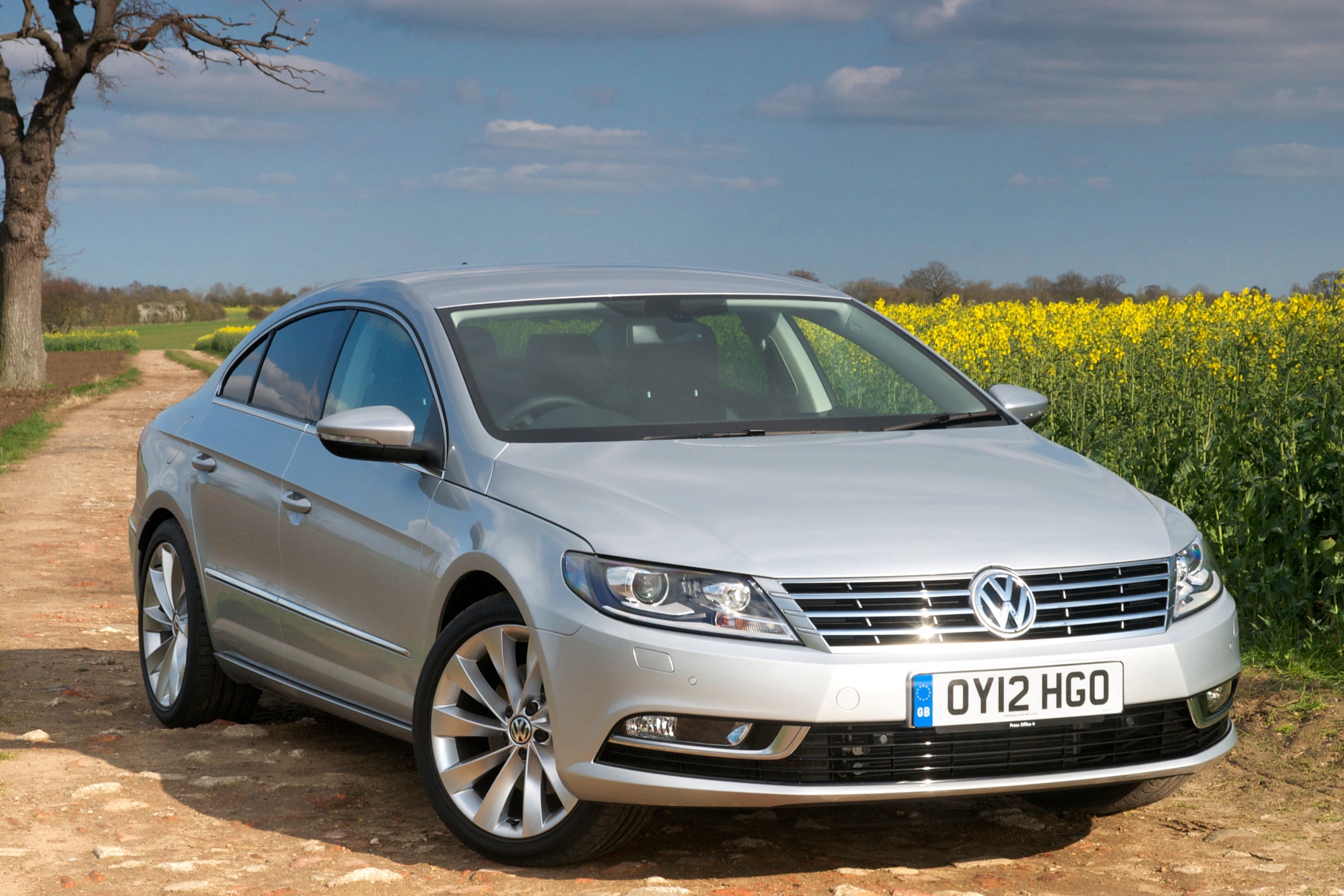Volkswagen CC (2012-2017) Review
Quick overview
Pros
- Swoopy looks
- Strong petrol engines
- Generous equipment
Cons
- Bland handling
- Rear seats for two in reality
- Boot access
Overall verdict on the Volkswagen CC
"Volkswagen dropped the Passat part of the CC’s name when the new model pitched up in 2012. This was a deliberate attempt to distance the four-door coupe model from its more humdrum mainstream sister, yet buyers remain unconvinced."
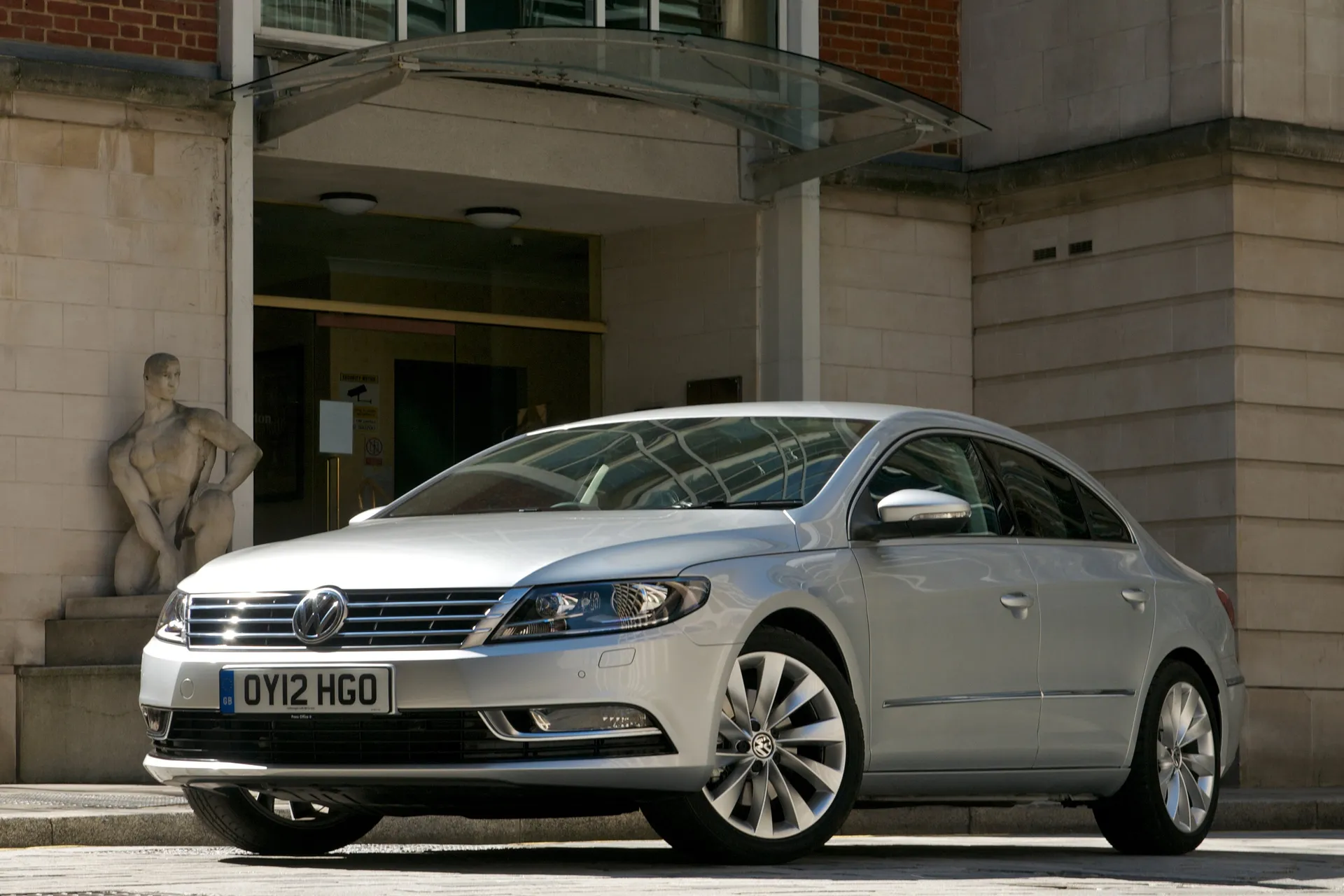
While Volkswagen may have been embarrassed by the CC’s Passat origins, that generation of Passat was one of the most capable family cars of its period. It follows the CC is also very able and it comes with a welcome extra sporting glint in its headlight thanks to its looks and the way it drives.
The engine range comprised 1.8-litre TSI 160PS or 2.0-litre TSI 210PS petrols and a 2.0-litre TDI common rail diesel with either 140PS, 170PS and 184PS. Each version of the TDI was offered with fuel saving BlueMotion Technology. Plus, all models with 170PS or more have an XDS differential as standard. This is the same system that features on the Golf GTI and uses the electronic traction control system to improve cornering and traction.
Of course, the most obvious expression of this sporty nature is the CC’s coupe styling. Unlike other car makers that use the CC moniker to denote a coupe-cabriolet model, the Volkswagen CC is very much a fixed roof machine. It has four doors, in the same mould as the Mercedes CLS or BMW 6 Series Gran Coupe.
The CC's front cabin is very similar to the contemporary Passat’s, which is no bad thing as it’s precisely laid out and well made. The rear has frameless doors just like the front pair and they open to reveal a back seat with only two proper seats and very slim centre pew. This limits versatility to some degree, but then coupe buyers are less likely to have that as a top priority. Read headroom is not as good as the Passat saloon’s, but it’s certainly not poor. There’s also a decent boot, so the CC makes a sound case for itself.
All models come with touchscreen sat nav, DAB digital radio, iPod and Bluetooth connectivity, two-zone climate control, 17-inch alloy wheels and xenon headlights. Again, this gives the CC a good slice of buyer appeal.
It may not be as sharp to drive as a BMW 3 Series Gran Coupe or Audi A5, which are the CC’s closet real world rivals, but it’s decent value, easy to live with and cheap to run. The Vollkswagen CC was effectively replaced by the Volkswagen Arteon in 2017.
Looking for a used car for sale? We've got 100s of Volkswagen Approved Used Cars for Sale for you to choose from, including a wide range of VW CC cars for sale.
Is the Volkswagen CC right for you?
If you need more than four seats in your car, the Volkswagen CC is not for you. While not a strict four-seater, the middle pew in the back is so slender and uncomfortable it might as well not be there. Think of it as more of a get-you-home option if you really have to take three across the back bench.
Rear headroom is not as tight as you might imagine given the CC’s sloping coupe styling, so it does work as a family car for Mum, Dad and the two kids. There’s even a decent boot when you open the lid and the rear seats can be divided 60-40 to tumble forwards and free up even more space.
With only one body style to choose from, the decision is down to whether you prefer the standard model or the upscale GT version. The GT gained heated front seats, full Nappa leather upholstery, three-mode adaptive chassis control, cruise control, front and rear parking sensors, 18-inch alloy wheels, front fog lights and rear privacy glass. An R Line model was added later on with adaptive headlights.
What’s the best Volkswagen CC model/engine to choose?
When it comes to which trim level of Volkswagen CC we’d look for, it’s a bit of a no-brainer to focus in on the GT specification. While the standard model is well kitted out and comfortable, the GT gains all-round parking sensors that are a real boon due to the CC’s high-waisted rear end. You also get leather upholstery, cruise control and an adaptive chassis in the GT that makes it more sporty to drive.
When it comes to engines, there are three petrol and two diesels to pick from. Turbodiesel power is dealt with by 140-, 170- and 184PS versions of the usual 2.0-litre TDI motor. The least and most powerful motors have the choice of six-speed manual or DSG automatic gearboxes, while the 170PS unit only comes with the DSG self-shifter.
Don’t discount either of the petrol engines as the 160PS 1.8 TSI is very well suited to the CC and the 210PS 2.0-litre is lifted from the Golf GTI. This latter unit gives the CC the performance it needs to live up to the looks, taking care of 0-62mph in 7.6 seconds on the way to a 150mph top speed. It’s the one we’d have.
There is also the 150PS 1.4-litre turbo- and supercharged petrol. However, it misses the XDS electronic front differential of the more powerful models.
What other cars are similar to the Volkswagen CC?
The two most direct rivals for the Volkswagen CC are the Audi A5 Sportback and the BMW 4 Series Gran Coupe. Both make the same attempt to offer coupe looks and four-door practicality as the Volkswagen and have the same compromises too. However, this pair have a more prestige image than the CC and the BMW is easily the best of the three to drive.
You might also consider the Volvo S60 as a more upmarket family saloon and it’s available with engines that range from the very frugal to the downright fast.
Comfort and design: Volkswagen CC interior
"Some may comment the Volkswagen CC’s front cabin is all bit too similar in style to the Passat of the same era. We say that’s a good thing as the Passat was always a handsome car from the driver’s seat and that's carried over to the CC."
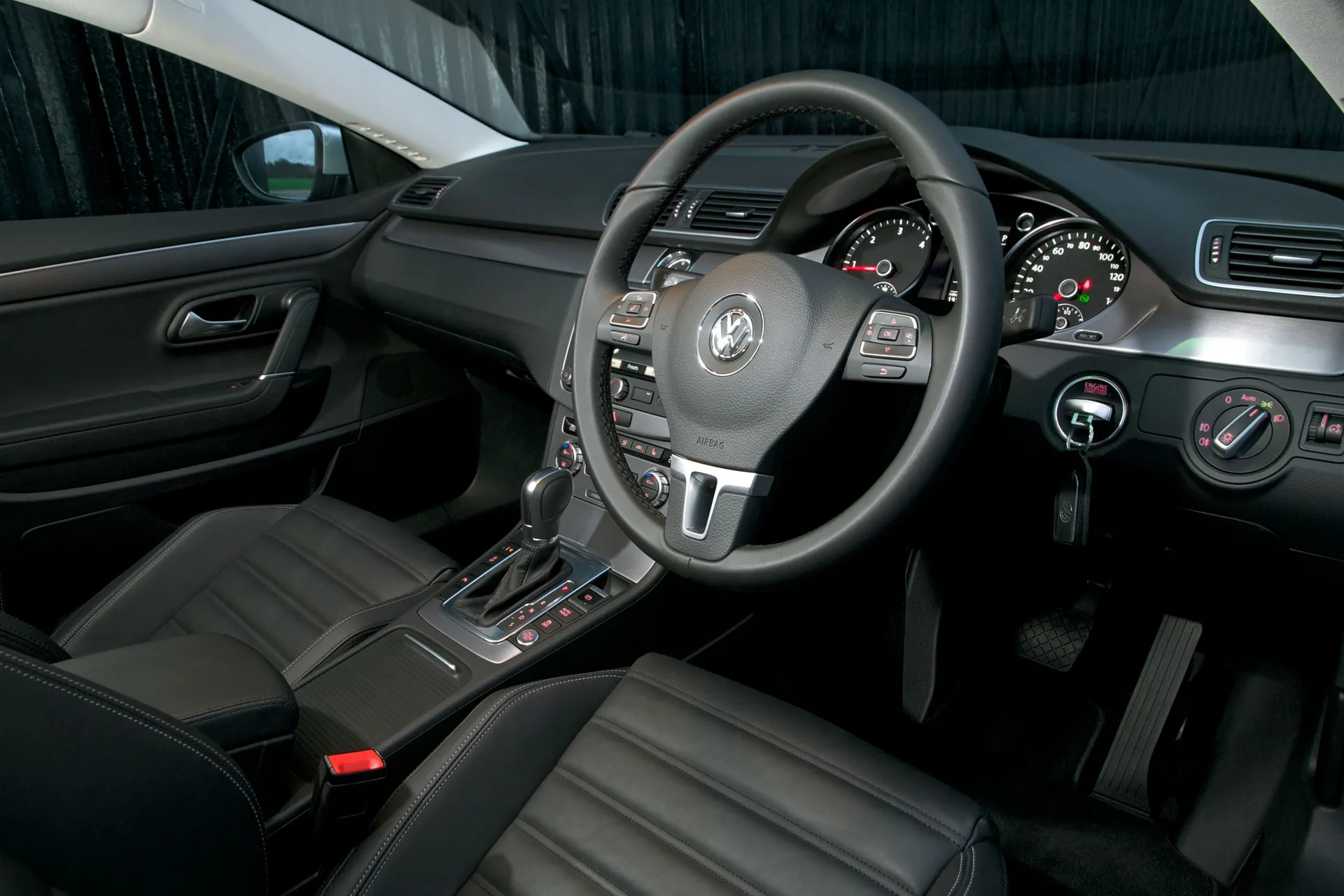
Everything you touch in the CC feels well made from the door handles to the gear lever, buttons and steering wheel.
The driver’s seat offers good support, even if the cushions feel a little firm on first acquaintance. No matter, they deliver the sort of comfort that means you arrive at the end of a long drive without aches and pains. There’s also height adjustment for the driver and the steering wheel moves for depth and angle to further finesse the seating position.
There’s good legroom for even the tallest drivers, while shoulder and headroom are good but not quite as roomy as you’ll find in a Passat saloon. As for the view out from the driver’s seat, it’s fine to the front and sides, but the rear view is limited by the high waist and the slope of the roof that limits the size of the back window. However, the GT and R Line models come with all-round parking sensors as standard to overcome this.
Quality and finish
Volkswagen was very keen to set the CC apart from the Passat range and made a concerted effort inside the car to up it game.
All of the surfaces feel that bit more honed and higher grade than in the Passat. All of the buttons and switches work with a pleasingly positive action, clicking on and off with a reassuring sense of solidity.
The impression of quality could be pushed even further if the buyer opted for the acoustic windows that were an option. The thicker glass made the CC’s cabin more refined and hushed.
Infotainment: Touchscreen, USB, sat nav and stereo in the Volkswagen CC
Volkswagen fitted every CC model with a 6.5-inch touchscreen infotainment system that was quite advanced for the time at launch. It features satellite navigation as standard and DAB digital radio, so buyers today don’t have to worry about accessing their favourite station.
The RNS 315 infotainment system also comes with iPod and Bluetooth connectivity in all CC models, so it’s simple to pair a smartphone to the car for hands-free calls.
However, the touchscreen itself is a good size and easy to reach from the driver’s seat. The graphics are clear and bold, and there are shortcut buttons on either side of the screen to take you to the main function menus without having to scroll through many pages.
It’s also worth noting that Volkswagen did not believe in pushing every system through the infotainment, so there are separate, simple controls for the ventilation beneath the screen. On the steering wheel are remote controls for the usual stereo and hands-free functions, while behind the wheel is a stalk for the cruise control.
Space and practicality: Volkswagen CC boot space
The Volkswagen CC may be a four-door coupe, but that does not mean it abandons any hope of carrying rear seat passengers with a degree of comfort and space. Far from it, in fact, as the CC offers a surprisingly generous amount of head room for adults, so there’s no need to contort or crouch to fit in the back of this coupe.
The CC also comes with a lot of legroom for those in the back seats, even when those occupying the front chairs are taller. This is a welcome side effect of the CC being based on the Passat, which was easily one of the most spacious cars in its class at the time.
However, there is a caveat to all of this and that’s the centre seat.The middle seat is very narrow, thinly padded and offers limited space for feet. All in all, not even children will feel very comfortable travelling here for any length of time beyond a quick jaunt to the school gates.
Move round to the rear of the CC and the boot lid has a noticeable slope to it due to the coupe design of the car. This dictates an opening that’s smaller than a Passat saloon’s, so fitting in larger cases will require a little juggling to make them fit. There’s a small drop from the load sill to the boot floor, but the load bay itself is long, flat and has uninterrupted sides, so you can fit a lot into the large 452-litre space.
The rear seats of the CC are divided 60-40 and tip forwards to free up more room. It’s easy to do this, though with the seats tumbled flat you are still hampered by the low boot opening.
Handling and ride quality: What is the Volkswagen CC like to drive?
"CC stands for ‘Comfort Coupe’ and it certainly errs more on the side of grand tourer than out and out sports car."
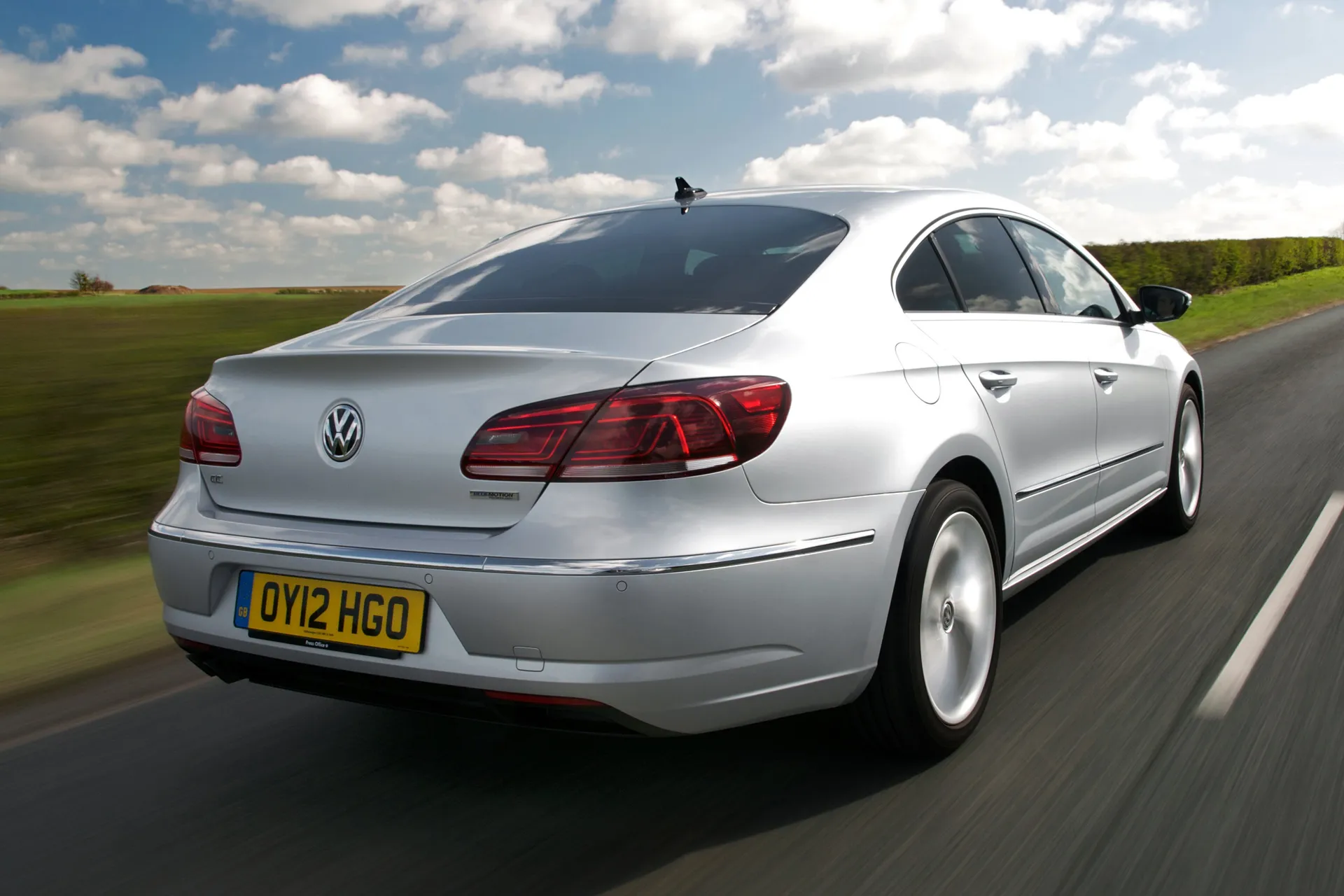
This is immediately obvious from the ride that absorbs almost all lumps and bumps in the road with a determined efficiency. There isn’t quite the fluid feel of a BMW 3 Series here, but the CC rarely feels like it’s crashing into a pothole unless you have the later R Line models on larger wheels that could become a little harsh on the worst tarmac.
With the GT and R Line models, you get the ACC active chassis control set-up that offers a choice of Normal, Comfort and Sport settings for the suspension. While the Comfort and Sport offerings do as they say, we doubt many drivers will bother fiddling with the modes beyond the first few days of ownership as the Normal operation is just fine at balancing suppleness with control.
Having established the CC is a comfy partner for any trip, it can also pick its way along twisty roads relatively well. Again, it’s no BMW 3 Series, but it can be decent fun if you opt for the more powerful petrol or diesel models that have the XDS electronic differential that quells wheelspin in tighter corners and makes the CC more entertaining to drive.
Even so, the CC is no match for a Golf GTI, so if it’s driving excitement your looking for with a Volkswagen badge, the GTI or Scirocco are the places to go looking for it.
What engines and gearboxes are available in the Volkswagen CC?
The smallest engine in the Volkswagen CC line-up is the 150PS 1.4 TSI unit. It’s both turbo- and supercharged, which accounts for its strong power output and sprightly performance. While it’s fun to push this engine quite hard, we find the larger 1.8-litre turbo petrol with 160PS is the better bet as it has more low-down pull and makes for easier motorway cruising. Both were offered with manual or twin-clutch DSG auto gearboxes.
Or, there’s the 210PS 2.0-litre turbo petrol. This engine is lifted from the Golf GTI and, while not turning the CC into a sports car, it makes it brisk enough to have some fun in. It also comes with the XDS differential as standard and a DSG gearbox as an option in place of the six-speed manual transmission, though we’d stick with the manual.
On the diesel front, it’s a choice between 140PS (later 150PS), 170PS and 184PS versions of the ubiquitous Volkswagen 2.0-litre motor. The 170PS version only comes with the DSG gearbox and is well suited to this, while the 140PS and 184PS units could be had with the six-speed auto or a six-speed manual.
Out of all of these engines, the 150PS turbodiesel is the workhorse of the range and came with a claimed combined economy of 62.8mpg. As a result, it was popular with company drivers and still offers affordable running costs today.
Refinement and noise levels
There’s no getting away from the fact the 2.0-litre turbodiesel engine is not the quietest or smoothest of motors, especially when compared to those used in the likes of the BMW 3 Series or Volvo S60. When pushed to get the Volkswagen CC up to motorway speeds in haste, it has a coarse edge to its sound, though this settles down and thankfully it’s happy to cruise quietly.
The petrols are all more settled and subdued when revved hard, though the 1.4 TSI makes a distinctive and mildly pleasing whirr thanks to its turbo- and supercharging.
Where the six-speed manual gearbox is fitted, it has an easy, light shift, though it’s not snickety precise like you find in a Honda Accord. As for the DSG auto ’box, it transitions from one gear to the next quickly and with very little slur or delay. It’s also rarely wrong-footed if the driver makes a sudden demand for accleration.
Thanks to the sleek lines of the CC, wind noise is not a problem at high speeds and road noise is also effectively quelled, underlining this car’s focus on comfort over driving thrills. New buyers could also specify thicker door glass to further reduce the chances of exterior noise from entering the cabin.
Safety equipment: How safe is the Volkswagen CC?
Euro NCAP did not test the Volkswagen CC specifically, but it did test the Passat which the CC is based on. It scored a full five-star rating, so it’s safe to assume the CC will perform in a similar manner should it be involved in a collision.
Every CC comes with twin front, side and curtain airbags as standard, along with ESP traction and stability control. There’s also a driver alert system to tell you when to take a break to avoid fatigue on longer drives. There are three-point seat belts for all occupants, plus Isofix child seat mounts on the two outer rear seats.
The GT model came with all-round parking sensors, which are very welcome as the CC has a tall boot that makes reversing tricky to judge where the rear-most extremity of the car lies. Customers could also opt for a blind spot warning system with a flashing alert in the door mirror if a car's hidden in your blind spot.
Another option was a lane keeping assistance system that vibrated the steering wheel if the car wandered to the edge of its lane. Should the driver fail to respond to this, the car will guide itself back into the centre of the lane. Also, buyers had the chance to add a traffic sign recognition system with displays the speed limit on the car's infotainment screen.
MPG and fuel costs: What does a Volkswagen CC cost to run?
"The most economical model of Volkswagen CC is the 2.0-litre turbodiesel with 140PS, or later 150PS, with the BlueMotion range of efficiency enhancements."
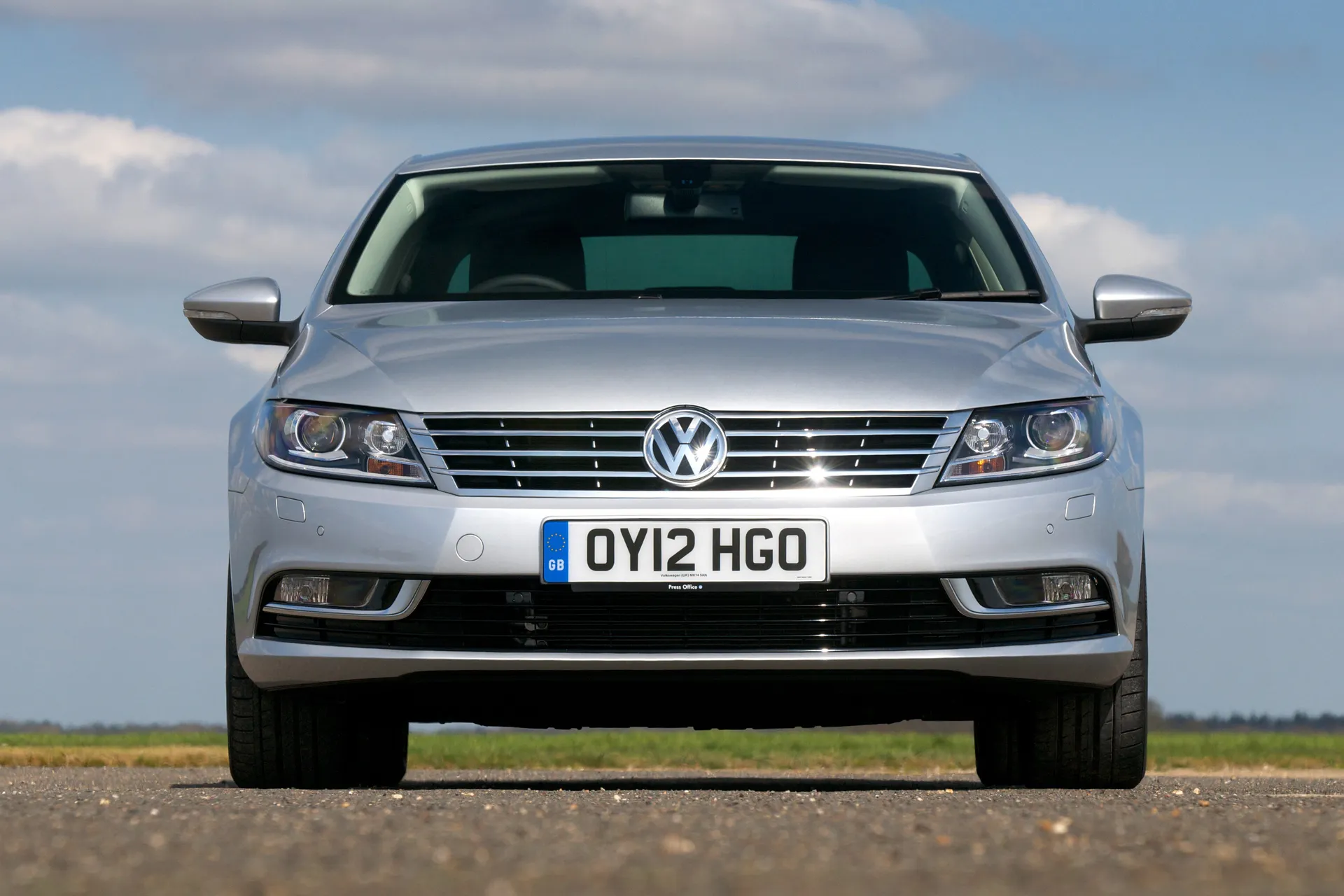
That included an engine stop-start system to turn off the motor when the car was at a standstill in traffic to reduce fuel use and emissions. It worked to deliver a claimed combined consumption of 62.8mpg, which was measured before WLTP regulations. Real MPG figures show this model is able to give up to 54.9mpg, which is 87 per cent of the claimed figure.
VED car tax: What is the annual road tax on a Volkswagen CC?
Choose either of the 2.0-litre turbodiesel engines in the Volkswagen CC and you will pay £30 per year for Vehicle Excise Duty. This is the same for the 150PS version of this engine, while the 170PS attracts a yearly payment of £165 and the 184PS comes in at £125.
For the petrol engines, the 1.4 TSI will cost you £125 per year for road tax, while the 1.8 TSI turbo petrol requires £205. Go for the 210PS 2.0-litre unit and its VED is priced at £240 per annum.
How much should you be paying for a used Volkswagen CC?
"Search out a late version of the Volkswagen CC and you will pay around £12,000 for a petrol or diesel model with 35,000 to its name. This will be from a dealer and come with some form of used warranty to give peace of mind. It will also likely be a well equipped GT or R Line model."
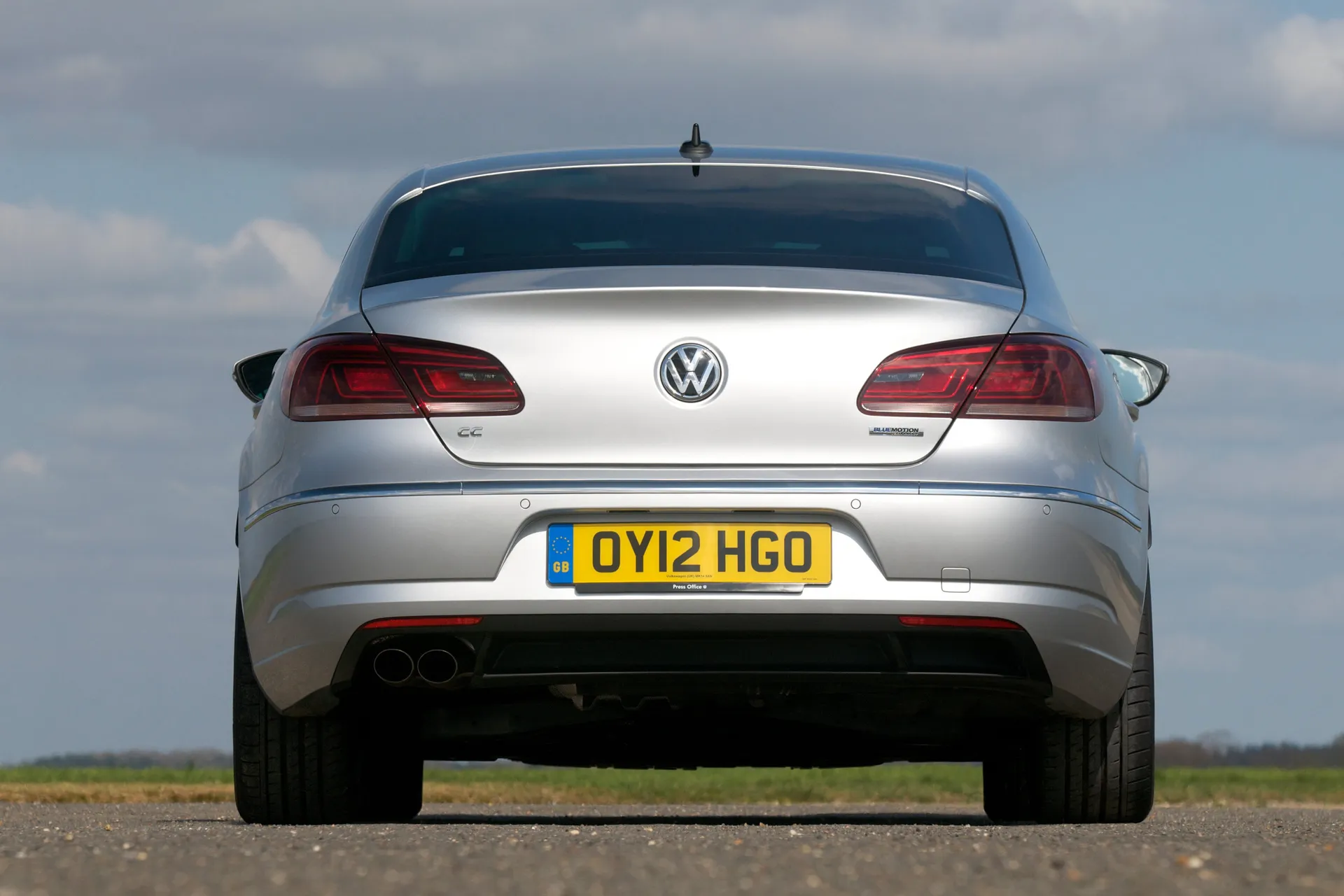
Look for an older CC and an eight-year old example with 75,000 miles under its wheels will cost you from £6000 for a car in good order and with complete service record. This sort of price will give you a choice of petrol or diesel engines and also the option of manual or automatic gearbox depending on which combination suits your needs.
Trim levels and standard equipment
Volkswagen was far from mean when it came to the standard equipment list for the CC. Entry-point models came with bi-xenon headlights, sports suspension, automatic headlights and wipers, and electric windows all round. There were also 17-inch alloy wheels, while inside you got dual-zone climate control, 6.5-in infotainment screen with sat-nav, Bluetooth and DAB digital radio, and electrically adjusted driver’s seat.
To this lot, the GT added 18-inch alloys, front foglights, parking sensors front and back, and the ACC adaptive chassis control with Normal, Sport and Comfort settings. There was Nappa leather upholstery and heated front seats for greater luxury. R Line models have adaptive headlights that were an option for others as High Beam Assist. Other additional equipment you could pay for included a reversing camera, front climate seats with massage function, thicker acoustic dampening door glass, and an electrically deployable tow bar.
Ask the heycar experts: common questions
What is the difference between VW Passat and CC?
Does Volkswagen still make the CC?
What does the CC in the name stand for?
Is the Volkswagen CC a good car?
Get our latest advice, news and offers
Keep me updated by email with the latest advice, news and offers from heycar.
By submitting you agree to our privacy policy
